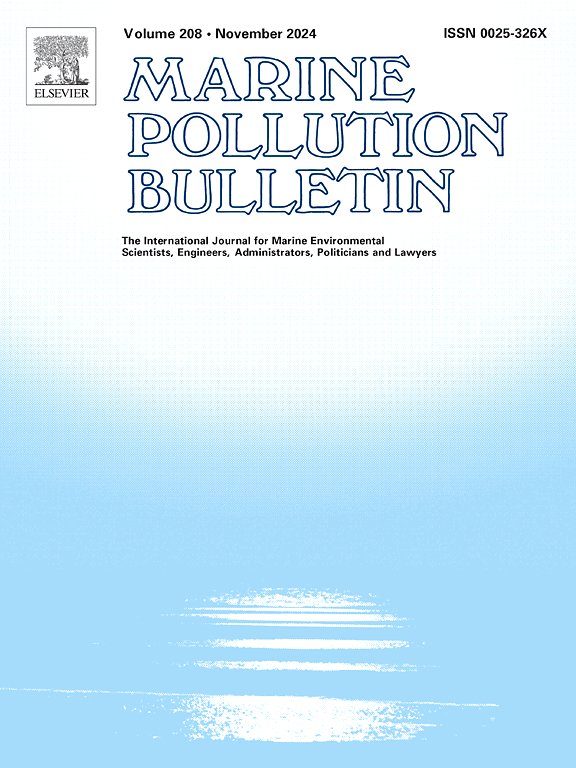An enhanced Cumulative Impact Assessment framework supporting Ecosystem-based Coastal Spatial Planning and Blue Growth in a data-poor region
IF 5.3
3区 环境科学与生态学
Q1 ENVIRONMENTAL SCIENCES
引用次数: 0
Abstract
Ecosystem-based Coastal Spatial Planning (EB-CSP) addresses the substantial need for assessing the cumulative impacts of coastal human footprint on ecosystem services. This study proposes a holistic Cumulative Impact Assessment (CIA) methodology, leveraging open-source and modelled geospatial data, exemplified in the data-limited coastal zone of Heraklion Prefecture. The methodology assesses the impacts of land- and sea-based anthropogenic activities on Final Ecosystem Services (FES) as assessment endpoints and explores the spatial variations in CIA results engaging spatial autocorrelation and hotspot analysis. Thus, Geodetector analysis was conducted to investigate the spatial differentiation and driving mechanisms of CIA distribution, still unknown in marine regions. Results revealed that shipping and fishing activities contributed to the higher CIA values, with P. oceanica meadows being the most impacted FES. Impact hotspots were concentrated near urban centres, reflecting regional differentiation. Factor detection identified land-based activities as driving forces impacting the study area and in the northern part separately, while bathing waters dominated in the south. Among ecological influencing factors, Photosynthetically Active Radiation (PAR) was highlighted at the study area level, whereas P. oceanica was predominant regionally. Synergistic interactions prevailed between land-based activities and PAR in the study area overall, between spawning areas with urbanization and tourism in the north and bathing waters with agriculture and urbanization in the south. The proposed methodology facilitates the identification of priority conservation zones and informs decision-making for managing driving human activities in the EB-CSP context while offering actionable recommendations for future impact mitigation and sustainable ecosystem services utilization in data-limited coastal regions.

支持数据匮乏地区基于生态系统的沿海空间规划和蓝色增长的增强型累积影响评估框架
基于生态系统的沿海空间规划(EB-CSP)解决了评估沿海人类足迹对生态系统服务的累积影响的实质性需求。本研究提出了一种全面的累积影响评估(CIA)方法,利用开源和建模地理空间数据,以伊拉克利翁州数据有限的沿海地区为例。该方法以陆地和海洋人为活动对最终生态系统服务(FES)的影响为评价终点,利用空间自相关和热点分析探讨了CIA结果的空间变化特征。因此,通过地理探测器分析,探讨海洋区域CIA分布的空间分异及其驱动机制。结果表明,航运和渔业活动对海洋草甸FES的影响较大,其中海洋草甸FES受影响最大。影响热点集中在城市中心附近,反映出区域差异。因子检测发现,陆地活动是影响研究区和北部的驱动力,而南部以洗浴水域为主。在生态影响因子中,光合有效辐射(PAR)在研究区水平上表现突出,而海洋藻在区域水平上占主导地位。总体而言,研究区域的陆上活动与PAR之间、北部城市化和旅游业的产卵区与南部农业和城市化的洗浴水域之间存在协同作用。拟议的方法有助于确定优先保护区,并为EB-CSP背景下管理驱动人类活动的决策提供信息,同时为数据有限的沿海地区未来减轻影响和可持续利用生态系统服务提供可行建议。
本文章由计算机程序翻译,如有差异,请以英文原文为准。
求助全文
约1分钟内获得全文
求助全文
来源期刊

Marine pollution bulletin
环境科学-海洋与淡水生物学
CiteScore
10.20
自引率
15.50%
发文量
1077
审稿时长
68 days
期刊介绍:
Marine Pollution Bulletin is concerned with the rational use of maritime and marine resources in estuaries, the seas and oceans, as well as with documenting marine pollution and introducing new forms of measurement and analysis. A wide range of topics are discussed as news, comment, reviews and research reports, not only on effluent disposal and pollution control, but also on the management, economic aspects and protection of the marine environment in general.
 求助内容:
求助内容: 应助结果提醒方式:
应助结果提醒方式:


